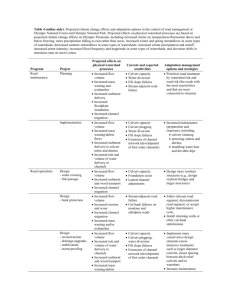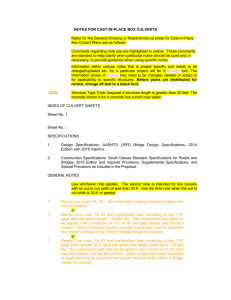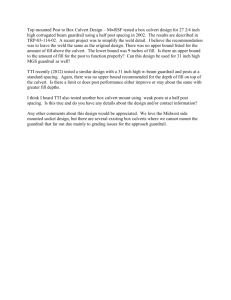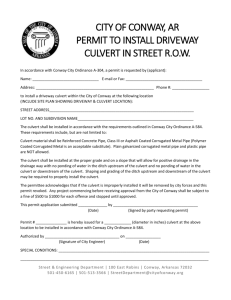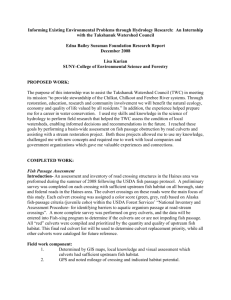storyboard_sec5_field assessment_NG
advertisement
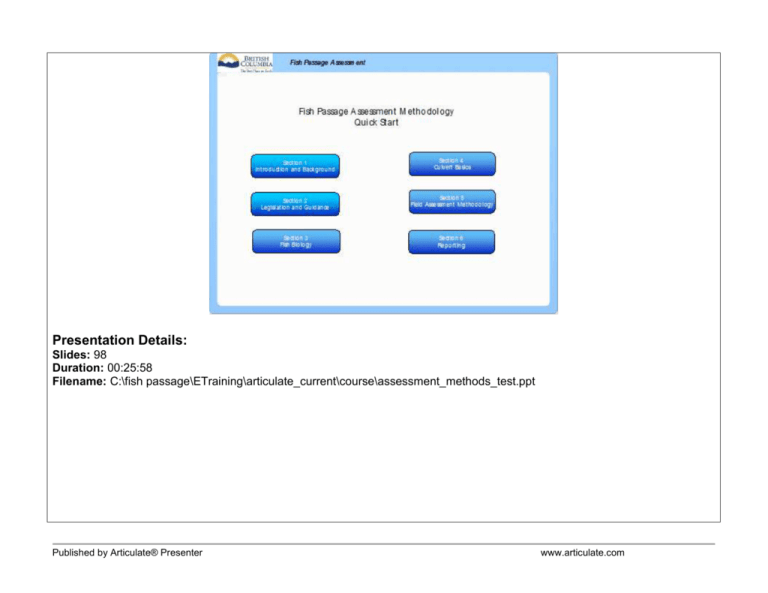
Presentation Details: Slides: 98 Duration: 00:25:58 Filename: C:\fish passage\ETraining\articulate_current\course\assessment_methods_test.ppt Published by Articulate® Presenter www.articulate.com Slide 53 Section 5: Field Methodology Notes: Duration: 00:00:05 Advance mode: Auto Hello, my name is ?. This section presents the main part of this course and explains the information and measurements associated with the field methodology to assess culverts for fish passage. This field assessment provides a procedure to quickly answer the question: “Does this stream crossing likely provide safe fish passage?” The objective is to effectively answer this question in as little on-site time as possible. The protocol uses a cumulative scoring approach because determinations of fish passage often involve evaluating a suite of indicators rather than assigning a simple yes/no response to a single threshold value. The methodology has been designed to be carried out by a team of two preferably with an individual with a fisheries background and one with a road layout and engineering background. It is a quick methodology and should take no longer than 15 minutes to carry out. On completion of this section, learners will be able to conduct a field assessment to determine the fish passage status of a culvert. They will understand the concepts associated with the methodology and be able to demonstrate all of the associated measurements It is a good idea to print out the data sheet from the Assessment methodology and follow along as we go through the measurements Published by Articulate® Presenter www.articulate.com Slide 54 Data Collection Phase Notes: Duration: 00:02:03 Advance mode: Auto Presenter Details: Name: Richard Thompson Title: Head Monitoring Unit, Ecosystem Branch, BC Ministry of Environment Email: richard.thompson@gov.bc.ca So before we look at the field methodology, lets recap where this fits in to the provincial assessment process. Remember back in the introduction we talked about a 5 phase process that has been be developed to conduct a systematic, watershed-based approach to fish passage assessment in the province. Well the field assessment methodology is the second phase of this process.. This is where the data is collected and later analysed to produce an Implementation Plan to guide fish passage restoration. Now that we know where this section fits in the provincial process lets begin with the field assessment methodology Slide 55 Four Ways to Evaluate Culverts for Fish Passage Duration: 00:00:05 Advance mode: Auto Published by Articulate® Presenter Notes: There are at least 4 ways to evaluate culverts for fish passage… You could actually observe fish swimming through the culvert and document the results. You would however have to do this numerous times ensuring that various discharge events fish life cycle events were captured. Given the number of stream crossings we have to assess (remember there are potentially 200,000 culverts on fish streams out there) not a very efficient method. We could also conduct velocity measurements at each culvert site and compare these measurements with a fish swimming… again we would have to measure velocities at the various discharge events.. Another time consuming and inefficient approach. If we had streamflow data for each crossing we could conduct an hydraulic analysis for each and predict velocities for various discharge events… a reasonable approach if we had the data, which we don’t. You can probably already predict what's next… www.articulate.com the actual method we use.. Well your right.. We use a series of hydraulic surrogates (5 in fact) that are predictive of suitable conditions for fish passage. These are simple measurements like slope and culvert length… We are going to talk about these in detail but first why this methodology? Slide 56 This protocol is an example of the surrogate methodology Duration: 00:00:05 Advance mode: Auto Notes: The key advantages of this methodology are that it can learned reasonable quickly, it is fast and can be done whenever there is not snow and ice on the ground. And lastly, the measurements are repeatable and can be used in more detailed analysis to assist in identifying potential restoration options. This protocol focuses on CBS because of problems associated with fish passage if these structures are not properly designed and installed (Slaney and Zaldokas 1997). It is based on principles related to those hydraulic conditions within, above, and below a stream crossing that are necessary to provide safe fish passage. The measurement of hydraulic surrogates allows the assessment to be done over a wide range of stream conditions. It should be noted, however, that “proving” fish passage is beyond the scope of this assessment. Conclusive proof of fish passage requires more detailed data on water velocity at different flow stages combined with fish sampling (minnow traps and electro-fishing) both up and downstream of culverts. Nevertheless, the assessments outlined here enable reasonable inferences to be made about the effectiveness of fish passage and the impact on fish habitat at these locations. Published by Articulate® Presenter www.articulate.com Finally, the purpose of this assessment is to determine the likelihood that a culverted stream crossing provides safe fish passage; it should not be construed as providing design guidelines Design guidelines are provided in the Fish Stream Crossing Guidebook, B.C. Ministry of Forests et al. [2002]). For instance, if a closed bottom culvert has adequate embedding material that is only 30 cm deep in some parts, it can probably pass fish. However, this depth of embedding would be inadequate for a new design that requires deeper embedding to provide a safety margin to ensure adequate roughness and cover over the life of the culvert. Slide 57 Equipment List Notes: Duration: 00:00:05 Advance mode: Auto This list outlines the type of equipment that you will need to complete this assessment and is provided here for reference. Experience will dictate what additional items you may want to include. Slide 58 Field card Notes: Duration: 00:00:05 Advance mode: Auto The information collected is divided into three different categories – location and survey data; fish passage measurements and additional site information. The location and survey data (green above) is information that is collected for each site that describes where and when the survey was conducted and who conducted it. The fish passage criteria are the measurements taken to determine the fish passage status of a culvert. These five measurements are shown in red above. Finally, the brown section contains information that is used in the analysis and helps to identify potential restoration options. Published by Articulate® Presenter www.articulate.com So let’s look at the location and survey data that is collected.. Slide 59 Site Information Notes: Duration: 00:00:40 Advance mode: By user This slide is interactive and will explain the entries required for each item from 1-8 Slide 60 Fish passage criteria Notes: Duration: 00:00:05 Advance mode: Auto So this brings us to the 5 measurements that are used in determining the fish passage status of a culvert. These are: • • • • • degree of embedment outlet drop stream width ratio culvert slope and, culvert length These measurements are relatively easy and we will go through them in detail.. Published by Articulate® Presenter www.articulate.com Slide 61 9. Embedded Notes: Duration: 00:00:05 Advance mode: Auto Measurement 9 deals with embedment and looks for the depth of embedment and whether or not the embedding material is continous throughout the length of the culvert. There are three categories – full, partial and none. Slide 62 Depth of embedment Notes: Duration: 00:00:05 Advance mode: Auto Fully embedded will display a minimum of 30 cm or 20% of the height of the culvert of substrate material within the culvert at both ends The partial category will display continuous embedment but will not make the full criteria throughout the culvert. In other words, it will have material at both ends but does not have a minimum of 30 cm or 20% of the height of the culvert at both ends. The last category “none” either is completely void of material or has some material but is not continuous throughout the culvert. It is important to remember that you are looking for a “best fit” here and some judgment will be required to find the closest category in which to place the pipe. Keep in mind this is a surrogate for channel roughness with a fully embedded culvert having basically the same characteristics as the natural stream channel. Published by Articulate® Presenter www.articulate.com Slide 63 10. Outlet Drop Notes: Duration: 00:00:05 Advance mode: Auto Measurement 10 measures outlet drop, if one exists. The measurement is really quite simple and requires two measurement shown as A and B. A is the measurement from the invert of the culvert to the top of the pool. B is the measurement from the top of the pool to the bottom of the outlet control. A is relatively straight forward.. Understanding exactly where and how to measure “B” might be more of a challenge Lets look at this from a plan view perspective.. Slide 64 Outlet Drop Notes: Duration: 00:00:05 Advance mode: Auto There is usually a outlet control associated with a outlet pool that controls the height of the outlet pool. This is often a riffle crest at the tail of the pool. What we are really trying to measure is maximum height of the outlet drop. This would be attained when the discharge from the culvert stopped and the outlet pool drained to its lowest point. This lowest pool level would be attained once the water drained from the pool to the lowest level of the outlet control.. Obviously the outlet pool would continue to dry up if no further flow came from the culvert. We are not really interested in this level just the lowest pool (and hence maximum outlet drop) that would occur at the point that flow from the culvert stopped and the pool drained to the lowest point controlled by the outlet control. A illustration of what we want to measure can be illustrated by a simple diagram Published by Articulate® Presenter www.articulate.com Slide 65 Outlet Drop Notes: Duration: 00:00:11 Advance mode: Auto Ok, let’s think of the outlet pool as a bucket and the outlet control riffle as a series of holes in the bucket… The outlet drop is A + B … A is the height from the bottom of the culvert to the top of the bucket or the top of the pool in the real world. Now water obviously leaves the pool at the pool outlet or the outlet control. The depth of water in the pool or the bucket in this case is controlled by the lowest hole in the bucket in our bucket scenario or the lowest point along the outlet control.. I hope this makes what we are trying to measure clear… Let look at some examples Slide 66 Outlet pic Notes: Duration: 00:00:05 Advance mode: Auto This slide is used to illustrate outlet drop Slide 67 Outlet pic Notes: Duration: 00:00:05 Advance mode: Auto This slide is used to illustrate outlet drop Published by Articulate® Presenter www.articulate.com Slide 68 Outlet pic Notes: Duration: 00:00:05 Advance mode: Auto This slide is used to illustrate outlet drop Slide 69 11. Stream Width Ratio Notes: Duration: 00:00:05 Advance mode: Auto Measurement 11 is Stream Width Ratio which is simply the Channel Width over Culvert Width. This metric gives some estimate of the size of the culvert versus the size of the channel. The ideal is to have the culvert width equal to or greater than the channel width or the stream width ratio equal to or greater than 1. Measuring culvert width is simple, just measure horizontally the widest part of the culvert whether round or elliptical. Channel width is a bit more challenging, but the technique is similar to that used in classifying stream channels under FRPA. So if you are familiar with this process you already have the idea. Lets look at a stream channel and talk about a few simple guidelines… Slide 70 Stream Channel Width Notes: Duration: 00:00:05 Advance mode: Auto So what are the key points in measuring channel width. First you want to take at least three measurements in a representative stretch of the natural stream channel. This will be outside of the right-of-way, away from any stream alterations. It really doesn’t matter whether you measure upstream or downstream, whichever is more convenient, as long you have a Published by Articulate® Presenter www.articulate.com representative section of stream channel. The channel width used in the stream channel width will be the average of the three measurements. A couple of more notes, if the channel exhibits a lot of variation you should take a few extra measurements to ensure you have captured the natural variability. Slide 71 Stream Channel Width Notes: Duration: 00:00:05 Advance mode: Auto Measurements should be taken at the edge of rooted vegetation or underneath cutbanks Slide 72 Multiple Culverts Notes: Duration: 00:00:05 Advance mode: Auto Before we move on to the next measurement we need to address a site where multiple culverts exist. How do we take these measurements at these sites? The answer is simple record the measurements using the culvert that is lowest in elevation. This is the one that will ultimately have the greatest affect on fish passage. Note the differences in the bottom elevations of each of the culverts. For the stream width ratio however, add the widths of all the culverts for the culvert width measurement. A diagram in the comments section would be useful noting the elevation differences. Pictures are always helpful as well. Let’s move on to the next measurment Published by Articulate® Presenter www.articulate.com Slide 73 12. Slope Notes: Duration: 00:00:05 Advance mode: Auto Measurement 12 records the slope of the culvert. Use your suunto to get an idea of the culvert slope. Sight up against a rust line or bolt line within the culvert to get this estimate. If this initial measurement is greater than 4 % or greater then just record the number and move on to the next measurement. However if the initial measurements is less than 4% or you can’t measure culvert slope using a suunto, use a more accurate instrument such as an auto level to to record culvert slope. Ensure you’ve got your level set properly by adjusting the levelling screws until the level bubble is in the middle.. Lets run through a simple slope measurement… Slide 74 Slope Notes: Duration: 00:00:05 Advance mode: Auto Slope is rise over run.. So lets say we have an inlet elevation of 190 cm and an outlet elevation of 250 cm. The difference between the inlet and outlet elevation or the rise is then 60 cm. The culvert length or run is 20 m or 2000 cm. So simply we have 60 cm over 2000 cm or .03. Expressed as a percent we have a culvert slope of 3 %... Ok lets move on to the next measurement… Slide 75 13. Length Notes: Duration: 00:00:05 Advance mode: Auto This is an easy measurement simply measure and record the culvert length to the nearest tenth of a meter. That’s it for the five measurements we use to determine the fish passage status of a culvert. Simple eh?? Published by Articulate® Presenter www.articulate.com Slide 76 Barrier Determination Notes: Duration: 00:00:05 Advance mode: Auto Ok, now that we have the information that is required to determine the fish passage status of a culvert lets look at how it is used. Remember we said earlier that the protocol uses a cumulative scoring approach evaluating a suite of indicators rather than assigning a simple yes/no response to a single threshold value? We take the data collected in measurements 9 through 13 and then assign a value from this table. A couple of quick notes… Properly embedded culverts are considered passable as per a natural stream channel so if the culvert you are evaluation has meets the fully embedded criteria no further consideration of the other surrogates is required. It is considered passable. For the barrier determination of multiple culverts, use the metrics from the pipe lowest in elevation at the outlet. For pipes installed at the same elevation at the outlet, add diameters for SWR criteria and use the highest outlet drop, slope and length measurement of the all the culverts. So, depending on the cumulative score, we then place the culvert or site with multiple culverts into one of three categories – passable, potential barrier or barrier Published by Articulate® Presenter www.articulate.com Slide 77 Barrier Determination Notes: Duration: 00:00:05 Advance mode: Auto This table is used to determine the final fish passage result. Culverts with cumulative scores of up to and including 14 are considered passable. A score of 15, up to and including 19 are potential barriers and those 20 or greater are considered barriers to fish migration. So let’s look at an example Slide 78 Example Notes: Duration: 00:00:05 Advance mode: Auto Say we have a non-embedded culvert with a 21 cm outlet drop, with a stream width ratio of 1.2 (channel width was measured 1.8 m and the culvert width was 1600 mm or 1.6 m. The slop of the culvert was 4% and the culvert length was 21 m Slide 79 Example cont. Notes: Duration: 00:00:35 Advance mode: Auto Ok what score would we get for this site? For measurement 9 we would get a 10 because the culvert is not embedded. An outlet drop of 21 cm would score a 5. For stream width ratio we score a 3 because the ratio is 1.2. A slope of 4 % scores a 10 and a length of 21 meters receives a score of 3. Now simply add the individual scores up and you get a cumulative score of 31 for this site. A score of indicates this site is a fish passage barrier. Published by Articulate® Presenter www.articulate.com Slide 80 Site information Notes: Duration: 00:00:05 Advance mode: Auto The remaining site information that is collected at each site helps in the analysis and restoration phases of the assessment process and may also in getting a better handle on the fish passage problem. They help in identifying what may be the best option for fixing the problem at a given site So lets look at what information is collected.. Slide 81 14. Outlet Pool Notes: Duration: 00:00:05 Advance mode: Auto Measurement 14 is the outlet pool depth and completes the measurements taken at the outlet of the culvert. Remember, we already have measurement “B” the depth of the outlet control, we needed that to calculate the outlet drop in measurement number 10. So what we do need now is the depth of the existing pool or measurement “C”. Once we have tha,t all we do is minus the height of the outlet control (“B”) from the existing pool depth and we arrive at the residual pool depth which will be the lowest pool depth expected. Remember outlet pools can be deep so exercise caution when doing these measurements and don’t get wet. Slide 82 15. Stream Slope Notes: Duration: 00:00:05 Advance mode: Auto Measurement 15 is stream slope and like channel width can be taken upstream or downstream. It should be recorded over the same stretch of stream where channel width measurements were taken. Remember, you are measuring slope for a representative section of the stream, away from any man-made influences. Published by Articulate® Presenter www.articulate.com Slide 83 16. Habitat Value Notes: Duration: 00:00:05 Advance mode: Auto Measurement 16 pertains to habitat value in the vicinity of the stream crossing. This is a subjective evaluation of fish habitat and the chart provides some broad guidance for the three categories. Be cognizant of the relative fish values of the watershed you are working in and rate the subject stream accordingly. Remember, this is a quick subjective evaluation, and not a detailed study of associated fish value. If you are working with someone else discuss the rating collaboratively, mark the applicable category and move on. This information, may help later when deciding which structures to fix. Slide 84 17. Depth of Fill Notes: Duration: 00:00:05 Advance mode: Auto Depth of Fill or measurement number 17 is simply an estimate of the depth of fill over the culvert. Record this estimate for the depth of fill over the culvert at the center of the road prism. Published by Articulate® Presenter www.articulate.com Slide 85 18. Valley Fill Notes: Duration: 00:00:05 Advance mode: Auto Measurement 18 is Valley Fill which is an estimate of the amount of fill below the culvert. There are three categories Deep Fill, Shallow Fill and Bedrock. This information is important when deciding on options for restoration. Deep Fill shows no visible signs of bedrock and is associated with alluvial systems on glacial till. Shallow fill may show some signs of bedrock near the surface. Bedrock is obviously for systems that are bedrock controlled. Embedded culverts will not be suitable options for systems with shallow fill or are bedrock controlled. Slide 86 19. Beaver Activity Notes: Duration: 00:00:05 Advance mode: Auto Measurement 19 is included to note any beaver activity that is or may influence future culvert placement. Simply circle the appropriate response. Slide 87 20. Inlet Drop Notes: Duration: 00:00:05 Advance mode: Auto Inlet drop is measurement 20 and notes any drop at the inlet to the culvert. It notes any significant difference of the elevation of the substrate at the inlet to the culvert. Published by Articulate® Presenter www.articulate.com Slide 88 21. Backwatered Notes: Duration: 00:00:05 Advance mode: Auto The degree to which a culvert is backwatered is measurement 21. This provides an estimate as to how far the outlet pool is backwatered into the culvert from the outlet. The backwatered portion of the flow shows little or no sign flow such as would be the case of the outlet pool. This measurement along with culvert slope can provide important indications of relative velocities within the culvert, an important fish passage criteria. Slide 89 22. Fish Sighted Notes: Duration: 00:00:05 Advance mode: Auto Measurement 22 makes note of any fish sighted. Any information about fish species, age class, and where these fish where sighted for example, upstream, downstream or within culvert is important anecdotal information that may be of some value in further decision making at a later date. Slide 90 23. Culvert Fix Options Notes: Duration: 00:00:05 Advance mode: Auto Measurement 23 provides an initial opinion by the surveyors as to what may be a suitable option to restore fish passage at the subject site. This is obviously not a definitive conclusion, merely an subjective exploration of a list of some options. The more experience the crew has from a road engineering perspective, the more they may be able to differentiate between the various options available. A survey crew should not spent much time here, remember, the idea is to complete these assessment quickly and move on to the next. If the crew does not feel competent to identifiy a solution then just leave this field blank. It is likely that any culvert identified for restoration will be revisited and solutions identified and discussed in detail. More detailed Published by Articulate® Presenter www.articulate.com information may need to be collected before a final solution is identified. So let’s look at the options available. One obvious option is to remove the structure and deactivate the road. You probably aren’t going to be able to conclusively identify this as an option at the time of the survey as this decision will likely involve a number of other road users. A second option is replacing the culvert with some type of open bottom structure. The span of the open bottomed structure along with any other relevant aspect of the OBS should also be noted. Option threes would see replacing the existing culvert with an embedded or streambed simulation design. Remember that embedded culverts are only allowed without a Fisheries Act authorization where fish habitat is considered marginal, stream slope is 6% or less and channel width is 2.5 meters or less. Also valley fill conditions must allow for successful embedment. The proposed length of the culvert of the culvert should also be noted. Slide 91 23. Culvert Fix Options cont. Notes: Duration: 00:00:05 Advance mode: Auto The next two options should be applied with caution. Further survey work such as stream profiling and analysis using software such as Fish Xing may be required to confirm their viability. Option four, adding stream substrate and a downstream weir, may be suitable where there is no outlet drop, stream slope is very low (less than 1%) and the culvert width is equal to or greater than the the channel width. In other words where the Stream Width ratio is equal to Published by Articulate® Presenter www.articulate.com or less than These rare scenarios may be found where culverts where initially designed as an embedded culvert but were not placed low enough in the stream profile. The addition of a downstream weir may reduce velocities to allow for the retention of stream substrate within the culvert. Slide 92 23. Culvert Fix Options cont. Notes: Duration: 00:00:05 Advance mode: Auto Option 5 involves backwatering the culvert to reduce velocities and turbulence. This option should only be considered where the outlet drop is less than 30 cm, stream slope is less than 2 % and the stream width ratio is less than 1.2. Remember Stream Width Ratio is channel width over culvert width. This option, as with option 4 would require additional information to confirm its viability. At a minimum stream profiling and additional analysis using Fish Xing would be necessary. Slide 93 24. Photos Notes: Duration: 00:00:05 Advance mode: Auto The assessment requires that 5 photos be taken to document conditions at the site. The required photographs are: a shot of the downstream area to capture the downstream habitat; a shot of the outlet including any associated outlet drop; a shot of the culvert barrel from the downstream side. Upstream of the culvert two shots are required; one of the upstream habitat and a shot of the culvert inlet. The key points to remember is to ensure that you have labeled your photos with the unique crossing number and which of the 5 photos it is. Of course you can take as many photos as you wish but the five indicated above are the ones the assessment requires. Published by Articulate® Presenter www.articulate.com The final field on the assessment form, measurement 5 is a field for comments. Here you can enter whatever you feel is relevant or noteworthy about the stream crossing. You may want to add something that is unique about the crossing or a condition that may influence the decision about whether this is a good candidate for restoration. There is never a better time than when you are at the site to do this. So this completes section five outlining the field methodology. As you can see, the methodology is really quite simple and once you have had a chance to go through it a couple of times you will become quite proficient at completing it. So let’s move on to the quiz for this section. Slide 94 Quiz 5: Field Assessments Notes: Duration: 00:00:00 Advance mode: Auto Published by Articulate® Presenter www.articulate.com


